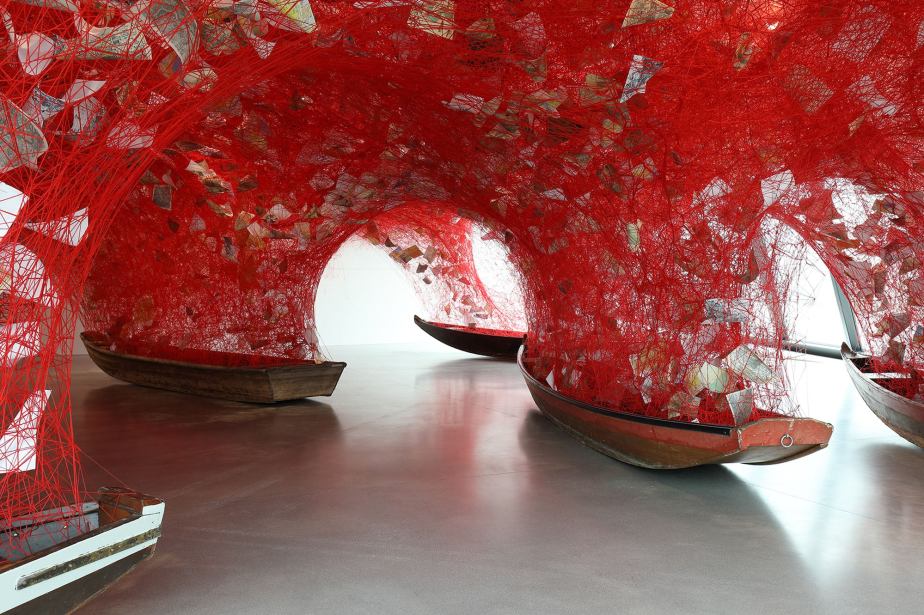“He looked into the water and saw that is was made up of a thousand thousand thousand and one different currents, weaving in and out of one another like a liquid tapestry of breathtaking complexity.” (Rushdie, 1993)
I think there’s a particular wonder and complexity created in arts pedagogies. Creative practice requires looking beneath the surface of the visual world and working toward new and adapted solutions to complex problems or creating original artifacts. Research underpins these creative practices, where visual sources are found, recorded, and connected. This way of researching and knowing is often embodied, sensory, and emotional. (Shreeve & Sims, 2012:56-59). For learners, I think wonder plays an important role in this – it is often where research starts and where it ends, but crucially there is no single thread to follow, and the route may be transitory, ambiguous, troubling, and fraught with internal and external obstacles before it becomes transformative.
I found Jarvis’s (2015) illustrated video very helpful for understanding transformative learning. Meaning perspectives frame the way we see the world. When learners encounter new knowledge in their research, they filter this through their own meaning perspectives. Transformative learning happens when we encounter new knowledge or have experiences that don’t fit into our ways of thinking and seeing. (Jarvis, 2015). I think research can be disorientating for learners because the process can challenge their fundamental ‘codes’. Mezirow (1997:6) states these can be “cultural, social, educational, economic, political, or psychological. Habits of mind become articulated in a specific point of view—the constellation of belief, value judgment, attitude, and feeling that shapes a particular interpretation’”. Transformative learning (the processes and findings of creative research) alters the way learners see and understand the world, and what they know.
Thinking back to my working week, a lot of these ideas and theories where present in my library workshops and tutorials with BA Fashion Atelier and BA Fashion Design students. It was a week very much about giving learners tools to guide them through their research. A few things I taught which I now recognise as threshold concepts, were search techniques and how to ‘explode’ or ‘narrow’ their ideas using keywords or mind maps. There’s an ‘aha’ moment within this for learners – they learn how to row (search), they wade through (evaluate) their findings – and begin to see/notice exciting connections and new ideas forming – research in of itself becomes transformative because it changes the way learners see/think about their creative practice.

Fig. 2 Lost Words Fig. 3 State of Being
I think these two images of Chiharu Shiota’s work illustrate the threshold and transformative processes of creative research and I’ve started using them more in my workshop slides. Learners go from gathering a tangled web of sources – to wading, sifting, stitching them together – until research is transformed into something more complex or whole – whatever that may be… the final garment, the narrative, the conclusion, or the learners thinking and ways of seeing.
Some actions:
- Through the weekly reflections on the PGCert, and reading up more on experiential learning, I’ve started to realise I’m a bit of an abstract thinker (I love a metaphor!) and this way of thinking permeates that way I teach. I think I need to start find ways to include more direct experience and concrete examples in my teaching, particularly to support learners who think more rationally and objectively. Something I need to create is guided handouts, practical examples, and step-by-step instructions in my library workshops – particularly for ‘go off and rummage’ activities in the library. I’ll try and find a few examples in the next week or so to start adapting and taking a bit more care with this.
- I’d like to explore how to support learners when their ‘codes’ or ‘meaning perspectives’ are challenged, so that learners “move toward a frame of reference that is more inclusive, self-reflective, and integrative of experience” (Mezirow, 1997:5). How can I get learners to slow down and contemplate all the words, images, research they find? How can I get them to challenge their findings and be more open to searching/seeking rather than dismissing information that doesn’t fit into their ways of thinking/seeing?
List of Figures
Fig 1. Shiota, C. (2022) Across the River. [Installation Art] At: https://www.koeniggalerie.com/blogs/news/chiharu-shiota-across-the-river (Accessed 08/10/2023).
Fig 2. Shiota, C. (s.d.) Lost Words. [Installation Art] At: https://annaschwartzgallery.com/asset/library/_fullscreen/Screen-Shot-2018-01-26-at-5.39.18-pm.png (Accessed 08/10/2023).
Fig 3. Shiota C. (s.d.) State of Being. [Installation Art] At: https://www.pinterest.com/pin/99642210491917890/ (Accessed 08/10/2023).
References
Jarvis, C. (2015) introducing transformative learning theory. At: https://www.youtube.com/watch?v=liU1zsi3X8w. (Accessed 08/10/2023).
Mezirow, J. (2002) ‘Transformative Learning: Theory to Practice. In: New Directions for Adult and Continuing Education 1997 (74) pp.5-1.2 At: https://go.exlibris.link/ZN1F3nqB (Accessed 08/10/2023).
Shreeve, A. and Sims, E. (2012) ‘Signature Pedagogies in Art and Design’ In: Chick, N. L. et al. Exploring More Signature Pedagogies: Approaches to Teaching Disciplinary Habits of Mind. London: Routeledge. pp. 55-67. At: https://go.exlibris.link/4RzGXFm6 (Accessed 08/10/2023).
Rushdie, S. (1993) Haroun and the sea of stories. London: Penguin Books.

